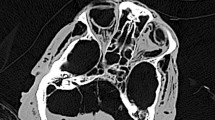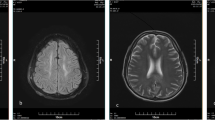Abstract
Objective
To investigate frequent findings in cases of fatal opioid intoxication in whole-body post-mortem computed tomography (PMCT).
Methods
PMCT of 55 cases in which heroin and/or methadone had been found responsible for death were retrospectively evaluated (study group), and were compared with PMCT images of an age- and sex-matched control group. Imaging results were compared with conventional autopsy.
Results
The most common findings in the study group were: pulmonary oedema (95 %), aspiration (66 %), distended urinary bladder (42 %), cerebral oedema (49 %), pulmonary emphysema (38 %) and fatty liver disease (36 %). These PMCT findings occurred significantly more often in the study group than in the control group (p < 0.05). The combination of lung oedema, brain oedema and distended urinary bladder was seen in 26 % of the cases in the study group but never in the control group (0 %). This triad, as indicator of opioid-related deaths, had a specificity of 100 %, as confirmed by autopsy and toxicological analysis.
Conclusions
Frequent findings in cases of fatal opioid intoxication were demonstrated. The triad of brain oedema, lung oedema and a distended urinary bladder on PMCT was highly specific for drug-associated cases of death.
Key Points
• Frequent findings in cases of fatal opioid intoxication were investigated.
• Lung oedema, brain oedema and full urinary bladder represent a highly specific constellation.
• This combination of findings in post-mortem CT should raise suspicion of intoxication.

Similar content being viewed by others
References
Degenhardt L, Bucello C, Mathers B et al (2011) Mortality among regular or dependent users of heroin and other opioids: a systematic review and meta-analysis of cohort studies. Addiction 106:32–51
Jones CM (2013) Heroin use and heroin use risk behaviors among nonmedical users of prescription opioid pain relievers—United States, 2002-2004 and 2008-2010. Drug Alcohol Depend 132:95–100
Barrio G, Montanari L, Bravo MJ et al (2013) Trends of heroin use and heroin injection epidemics in Europe: findings from the EMCDDA treatment demand indicator (TDI). J Subst Abuse Treat 45:19–30
Borg L, Broe DM, Ho A, Kreek MJ (1999) Cocaine abuse sharply reduced in an effective methadone maintenance program. J Addict Dis 18:63–75
Di Maio VJM, Di Maio DJ (2001) Forensic pathology. CRC Press, Boca Raton
Brinkmann B, Madea B (2003) Forensische Toxikologie. Handbuch gerichtliche Medizin, Springer, Berlin
Gable RS (2004) Comparison of acute lethal toxicity of commonly abused psychoactive substances. Addiction 99:686–696
Rohner C, Franckenberg S, Schwendener N et al (2012) New evidence for old lore - Urinary bladder distension on post-mortem computed tomography is related to intoxication. Forensic Sci Int. doi:10.1016/j.forsciint.2012.03.029
Levy AD, Harcke HT, Getz JM et al (2007) Virtual autopsy: two- and three-dimensional multidetector CT findings in drowning with autopsy comparison. Radiology 243:862–868
Baglivo SW M, Hatch GM, Ampanozi G, Thali MJ, ThD R (2013) The rise of forensic and post-mortem radiology—analysis of the literature between the year 2000 and 2011. Forensic Radiol Imaging 1-2013:3–9
Selwyn PA, Hartel D, Lewis VA et al (1989) A prospective study of the risk of tuberculosis among intravenous drug users with human immunodeficiency virus infection. N Engl J Med 320:545–550
Hser YI, Hoffman V, Grella CE, Anglin MD (2001) A 33-year follow-up of narcotics addicts. Arch Gen Psychiatry 58:503–508
Fryer EP, Traill ZC, Benamore RE, Roberts IS (2013) High risk medicolegal autopsies: is a full postmortem examination necessary? J Clin Pathol 66:1–7
Milroy CM, Parai JL (2011) The histopathology of drugs of abuse. Histopathology 59:579–593
Konstantinova SV, Normann PT, Arnestad M, Karinen R, Christophersen AS, Morland J (2012) Morphine to codeine concentration ratio in blood and urine as a marker of illicit heroin use in forensic autopsy samples. Forensic Sci Int 217:216–221
Geibprasert S, Gallucci M, Krings T (2010) Addictive illegal drugs: structural neuroimaging. AJNR Am J Neuroradiol 31:803–808
Taheri MS, Moghaddam HH, Moharamzad Y, Dadgari S, Nahvi V (2010) The value of brain CT findings in acute methanol toxicity. Eur J Radiol 73:211–214
Karch SB (2002) Karch’s pathology of drug abuse, 3rd edn. CRC Press, Boca Raton
Buttner A, Mall G, Penning R, Weis S (2000) The neuropathology of heroin abuse. Forensic Sci Int 113:435–442
Tessier DJ, Harris E, Collins J, Johnson DJ (2002) Stercoral perforation of the colon in a heroin addict. Int J Colorectal Dis 17:435–437
Levy AD, Harcke HT, Mallak CT (2010) Postmortem imaging: MDCT features of postmortem change and decomposition. Am J Forensic Med Pathol 31:12–17
Thali MJ, Yen K, Schweitzer W et al (2003) Virtopsy, a new imaging horizon in forensic pathology: virtual autopsy by postmortem multislice computed tomography (MSCT) and magnetic resonance imaging (MRI)–a feasibility study. J Forensic Sci 48:386–403
Brinkmann B (1999) Harmonization of medico-legal autopsy rules. Committee of Ministers. Council of Europe. Int J Legal Med 113:1–14
(2000) Recommendation no. R (99) 3 of the Committee of Ministers to member states on the harmonization of medico-legal autopsy rules. Forensic Sci Int 111:5-58
Takahashi N, Satou C, Higuchi T, Shiotani M, Maeda H, Hirose Y (2010) Quantitative analysis of brain edema and swelling on early postmortem computed tomography: comparison with antemortem computed tomography. Jpn J Radiol 28:349–354
Sarwar M, McCormick WF (1978) Decrease in ventricular and sulcal size after death. Radiology 127:409–411
Jamshidi F, Sadighi B, Aghakhani K, Sanaei-Zadeh H, Emamhadi M, Zamani N (2013) Brain computed tomographic scan findings in acute opium overdose patients. Am J Emerg Med 31:50–53
Weissleder R, Wittenberg J, Harisinghani MG (2011) Primer of diagnostic imaging, 5th edn. Elsevier/Mosby, St. Louis
J.A. Miller AS, C. Hinrichs, S. Contractor, S. Doddakashi (2000) Cardiac Dimensions Derived From Helical Ct: Correlation With Plain Film Radiography. Internet J Radiol. Available via http://ispub.com/IJRA/1/1/8223. Accessed 30 Sept 2013
Gollub MJ, Panu N, Delaney H et al (2012) Shall we report cardiomegaly at routine computed tomography of the chest? J Comput Assist Tomogr 36:67–71
Zeek (1942) The weight of the normal heart I. the weight of the normal human heart. Arch Pathol 34:820–832
Iino M, O’Donnell C (2010) Postmortem computed tomography findings of upper airway obstruction by food. J Forensic Sci 55:1251–1258
Sauvageau A, Boghossian E (2010) Classification of asphyxia: the need for standardization. J Forensic Sci 55:1259–1267
Kodama Y, Ng CS, Wu TT et al (2007) Comparison of CT methods for determining the fat content of the liver. AJR Am J Roentgenol 188:1307–1312
Park SH, Kim PN, Kim KW et al (2006) Macrovesicular hepatic steatosis in living liver donors: use of CT for quantitative and qualitative assessment. Radiology 239:105–112
Boyce CJ, Pickhardt PJ, Kim DH et al (2010) Hepatic steatosis (fatty liver disease) in asymptomatic adults identified by unenhanced low-dose CT. AJR Am J Roentgenol 194:623–628
Passarino G, Ciccone G, Siragusa R, Tappero P, Mollo F (2005) Histopathological findings in 851 autopsies of drug addicts, with toxicologic and virologic correlations. Am J Forensic Med Pathol 26:106–116
Frand UI, Shim CS, Williams MH Jr (1972) Methadone-induced pulmonary edema. Ann Intern Med 76:975–979
Steinberg AD, Karliner JS (1968) The clinical spectrum of heroin pulmonary edema. Arch Intern Med 122:122–127
Benyamin R, Trescot AM, Datta S et al (2008) Opioid complications and side effects. Pain Physician 11:S105–S120
Doyle PT, Briscoe CE (1976) The effects of drugs and anaesthetic agents on the urinary bladder and sphincters. Br J Urol 48:329–335
Bedford PJ (2012) Routine CT scan combined with preliminary examination as a new method in determining the need for autopsy. Forensic Sci Med Pathol 8:390–394
Acknowledgments
The scientific guarantor of this publication is Dr. Wolf Schweitzer, MD. The authors of this manuscript declare no relationships with any companies, whose products or services may be related to the subject matter of the article. The authors state that this work has not received any funding. One of the authors has significant statistical expertise. Institutional Review Board approval was obtained. Written informed consent was not required for this study because this was a retrospective study of deceased subjects. Methodology: retrospective, diagnostic or prognostic study, performed at one institution.
Author information
Authors and Affiliations
Corresponding author
Rights and permissions
About this article
Cite this article
Winklhofer, S., Surer, E., Ampanozi, G. et al. Post-mortem whole body computed tomography of opioid (heroin and methadone) fatalities: frequent findings and comparison to autopsy. Eur Radiol 24, 1276–1282 (2014). https://doi.org/10.1007/s00330-014-3128-7
Received:
Revised:
Accepted:
Published:
Issue Date:
DOI: https://doi.org/10.1007/s00330-014-3128-7




